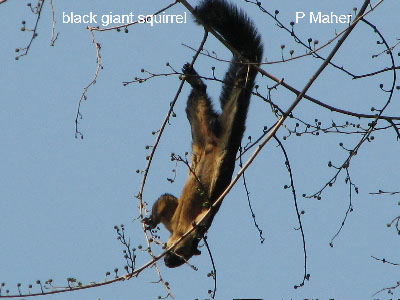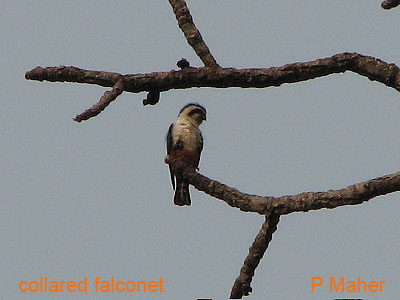Thailand bird trip report
11 March to 28 March 2010
Participants: Patricia Maher, Robin Marsh, Peter Marsh, Denise Moore, Frank O'Connor, Adrian O'Neil, Jack Shapiro. Leaders: Uthai Treesucon & Philip Maher
Day 1
We kicked off this tour by bagging one of our main target species: spoonbilled sandpiper at the Pak Than saltfields. Despite putting in a big effort, Uthai’s previous two tours missed this species, including a birding group just the day before so getting this species against the odds was particularly gratifying. This mega tick set the tone for the rest of the tour — lots of hard to find, spectacular species.Other notable species feeding at the saltfields were spotted redshank, Kentish plover, little and long-toed stints and Eurasian curlew.
Before leaving the shorebird area, we checked out some mangroves for golden-bellied gerygone, which we soon located. What else was in the area? How about greater flamingo! Adrian’s call of flamingo! was greeted with incredulousness by the rest of the group and certainly by me. Yet, there is it was, feeding on the ocean side of the mudflats. Uthai attempted to dampen our enthusiasm by suggesting it was an escapee that had been around for several years. Whether it migrated or not is uncertain (apparently birders don’t go out there in the winter). Consensus had it that it was a wild bird if it migrated and returned. Until I am convinced otherwise, it is a wild bird.
After lunch at a local restaurant we set off for Khao Yai, quite a way northeast of Bangkok, stopping only at a temple in the limestone hills where we looked for limestone wren-babbler. The first group we glimpsed was unco-operative but the second group was more obliging, bouncing around the limestone.
Other species seen included common iora, black-winged cuckoo-shrike, lineated barbet and our first black-crested bulbul for the trip. This area’s BCB, a subspecies, has a lovely red throat.
We stayed at Juldis Resort near Khao Yai NP (Thailand’s first national park).
Day 2
Up very early to head to the dry country of Tap Lan NP. The farmland along the way had some great birds and we soon saw rufous-winged buzzard (somewhat evocative of a brown falcon), fulvous-breasted woodpecker, purple sunbird, Burmese shrike, Eurasian kestrel, green bee-eater, barred buttonquail and spotted owlet. Pressed to beat the heat in the dry hot dipterocarp woodland of Tap Lan, we reluctantly moved on.Tap Lan’s woodland is similar to the tropical woodland in the top end of Australia and is also burnt off on a regular basis.
Birding along the road in Tap Lan gave us common flameback, grey-capped woodpecker, large woodshrike, Eurasian jay, large and Indo-Chinese cuckoo-shrikes and chestnut-bellied nuthatch. Local endemics, brown prinia and white-browed fantail were seen in this area. A large flock of migrating rosy minivet came through with a few ashy minivet amongst them. One of our chief targets here was black-headed woodpecker and it wasn’t until we were driving out that two fly across our path. With a bit of effort all had good views of this most impressive woodpecker.
We snacked on mango and sticky rice before heading back to the highway for a late lunch. The restaurant where we ate puts fruit out for the birds and squirrels. Enjoying this banquet were green-eared barbet, golden-fronted and blue-winged leafbirds, striped-throated, sooty-headed and black-crested bulbuls, dark-necked tailorbird, brown-throated and olive-backed sunbirds as well as variable squirrel. Photo opportunities constantly interrupted our own meal.
After lunch we took a short drive to a biosphere reserve for the stunning Siamese fireback. We soon located a group of about ten, both males and females. Siamese firebacks, well protected in this reserve, have become accustomed to humans and show little wariness.
Back to our accommodation for a late dinner.Day 3
Next morning saw us birding in earnest in Khao Yai NP and our first bird was a beauty — a pair of silver pheasants parading across the road. This was soon followed by our first trogon, a red-headed trogon. The super skulker, coral-billed ground-cuckoo was our next target but only Peter got a half decent look. After lunch we notched up a banded kingfisher and our first hornbill (pied) as well as hill myna. The antics of a black giant squirrel feeding above the road captivated us for a while.
Uthai got word that masked finfoot was in the park and we immediately set off to look for this major rarity. We located the large pool in the creek where it had been seen. A large Siamese crocodile, released in the park by unknown persons, also inhabited the pool. This crocodile is supposedly extinct in the wild in Thailand.
Finally, the finfoot was located in the heavily vegetated creek but flew off and disappeared, not to be seen again. I got a brief look at it flying off but Peter, inadvertently close to the bird, had a good view. Two mega birds in a day for Peter!
Day 4
Khao Yai to Bangkok
Another excellent species was ours as we birded the main entrance road in the park — golden-crested myna; new bird for me. Other good birds encountered along the road were great hornbill, Asian fairy bluebird and greater flameback.Birding further into the park bagged us our second trogon, the stunning orange-breasted trogon. We had another go for the ground cuckoo but I think it was only me that got a half-decent look. When Trisha and I first visited this park in 2007, this species was seen eating scraps behind one of the park’s restaurants.
More co-operative for all were white-browed scimitar babbler and white-crested laughing-thrush.
Banded broadbill was another good sighting before lunch as was white-handed gibbon.
We headed back to Bangkok after lunch but not before seeing Abbott’s babbler, blue-throated bee-eater, a superb male banded kingfisher literally at eye height; purple-throated sunbird, Hainian blue-flycatcher, scarlet-backed flowerpecker and blue-tailed bee-eater.
Day 5
Bangkok to Kaeng Krachen
This morning we birded Rangsit Marsh on the outskirts of Bangkok. The marsh was drier than normal due to a poor wet season all of South-East Asia had experienced. Some of the highlights were black-browed reed-warbler, lesser coucal, yellow bittern, bronzed-winged and pheasant-tailed jacanas, black-crowned night-heron, black bittern and dusky warbler. New bird for me was sand marten.Next stop was another temple for a pair of Alexandrine parrots, one of the few pairs extant in the wild in Thailand.
Heading southwest of Bangkok, we stopped by the highway at another swamp. More waterbirds were added as well as streaked and Asian golden weavers, yellow-bellied prinea, and a brief view of watercock.
Further south, we called in at the Royal Project Treatment Plant, which is usually reliable. And so it was today with ruff, spotted redshank, common and pin-tail snipes, ruddy-breasted crake and best of all: a pair of greater painted snipe. Our accommodation for the next four nights was the Kaeng Krachen Country Club near Kaeng Krachen National Park on the Isthmus of Kra.
Day 6
Kaeng Krachen National Park
An action packed day with a lot of exceptional birds seen. We started off in lowland thick with cuckoos. We soon had good views of violet, drongo and plaintive cuckoos, as well as racket-tailed treepie. A red-legged crake called from the rainforest but remained hidden.Our woodpecker list grew with grey-headed and common flameback. A black-thighed falconet perched briefly and we had a pair of green magpies. Great-slaty woodpecker called but did not show.
Great views were had of a pair of sultan tits at the campground where we had lunch. Also here, dusky langurs loafed around down by the creek.
Past the second creek crossing, the jungle canopy heaved with birds. We had nice views of heart-spotted woodpecker and rusty-cheeked hornbills were feeding young in the nest. Both greater and lesser necklaced laughing-thrushes were seen in a mixed flock and we finally saw orange-headed thrush, another new bird for me. The super shy grey peacock-pheasant came in frustratingly close but was not to be seen.
The day drew to a close with a pair of blue pittas and silver-breasted and black and yellow broadbills.
Day 7
Kaeng Krachen NP
A large fruiting fig near the park entrance had a host of birds feeding in it including orange-bellied and thick-billed flowerpeckers, oriental pied hornbills, vernal hanging parrots, thick-billed green pigeons and many black-naped orioles. Species of the day was not far from here, a pair of scaly-breasted partridges, which we lured in for an excellent look. We also had three grey-headed lapwings along the road.Beyond the first campground the birding was slower than the previous day, probably due to a change in the weather. Still, we got good looks at spot-necked babbler and a superb male yellow-rumped flycatcher, as well as brown-rumped minivet, Raffles’ malkoha, Asian barred owlet and lots white-handed gibbons.
Moving higher up the mountain we had a pair of streaked-breasted woodpeckers, banded broadbill and crimson sunbird. The shy and elusive bamboo woodpecker behaved in its normal shy and elusive manner providing only the briefest of views in flight. Our last bird of the day was a serpent eagle, complete with serpent, flying back to its nest at dusk.
Day 8
Our last day’s birding in the wonderful Kaeng Krachen NP, Thailand largest park. We ventured further up the mountain today to try for some of the higher altitude species. We had good views of great and wreathed hornbills before the second campground. Uthai called in a stunning male green broadbill — a species quite uncommon in Kaeng Kachen NP, followed by its congener, black and yellow broadbill and another pair of green magpies feeding young in the nest. We had one of the park’s specialities immediately before the second campground, the ratchet-tailed treepie.Other prized birds in this area included rufous-browed flycatcher, golden babbler and grey-chinned minivet.
Nearer the top of the mountain we saw the less common banded langur and also picked up grey-faced buzzard. At the top we scored white-browed piculet, red-bearded bee-eater, grey-breasted spiderhunter and black-throated sunbird. But it was on the way down that we scored some mega species in the form of long-tailed broadbill and the scarce white-hooded babbler.As evening approached animals were on the move. Elephants trumpeted right in the thick growth beside the van. Another lucky group had just seen two gaurs feeding along the road. We missed that but we did see a crab-eating mongoose and a large well-marked, not yet identified snake crossing the road.
Keeping alive the Maher tradition of wringing the last breath out of the day, a kindly guard, resigned to birders’ lack of timekeeping skills, emerged from his sentry box and opened the park’s locked gate.
Day 9
Kaeng Krachan to Bangkok to Doi Inthanon
An early morning stroll around the resort grounds produced vinous-breasted starling, thick-billed and lanceolated warblers, brown-throated sunbird and hoopoe, among others. In the park, around headquarters, we caught up with large scimitar-babbler, which showed well; plus puff-throated babbler and Radde’s warbler. We headed for Bangkok for our flight to Chiang Mai, seeing green and blue-tailed bee-eaters and baya weaver near rice fields along the way.Day 10
Doi Inthanon National Park
Our first stop this morning was a few kilometres from the summit of Doi Inthanon, Thailand’s highest mountain. Some of the species here included slaty-backed flycatcher, dark-backed sibia, chestnut-tailed minla and green-tailed sunbird. A flock of speckled wood-pigeon flew across and a taunting green cochoa called but didn’t show.We continued on to the summit, adding eye-browed and grey-sided thrush and for some of us, ashy wood pigeon. Some of the dreaded leaf warblers fell: Blyth’s, ashy-throated and buff-barred — all reasonably easy to identify.
The boardwalk had its highlights: snowy-browed flycatcher, the huge yellow-bellied flowerpecker and lots of white-browed shortwings.
Uthai heard a pygmy wren-babbler call near the road, not far from the summit, and to our surprise the bird came right out and sang for us. A nice end to the morning.
Off to Mr Deang’s restaurant and bird centre for lunch. After an exchange of formal greetings with Mr and Mrs Deang and before tucking into pad thai, we had nice looks at dark-sided thrush and hill blue flycatcher from the veranda.
After a siesta for some and a market shop for others, we ventured back up the mountain and birded along the road near the Jeep Track. Rufous-backed sibia, short-billed minivet, little pied flycatcher, silver-eared mesia, grey-checked fulvetta and small niltava were some of the species had along the road.
On the way down the mountain we called in to a pond where Uthai coached out a pair of well-fed black-tailed crakes.
Day 11
This morning we ventured into the dry dipterocarp forest only a short distance up the mountain. The cicadas were just hatching and collared falconets were everywhere; we must have seen at least five. Other raptors included oriental honey buzzard, shikra and some migrating black bazas
.
There were large flocks of rosy minivet about and we also managed to get the spectacular white-bellied woodpecker, South East Asia’s second largest woodpecker.Going a little further up the mountain most of us got, after much effort, the skulking white-gorgetted flycatcher as well as striated bulbul. While heading to Mr Deang’s for lunch we got a lovely male grey-backed shrike beside the road.
Another pad thai, another siesta. As we were leaving Mr Deang kindly gave each of us a banana. His mischievous grin suggested something amiss. The bananas were wild bananas – full of hard, round seeds. Beware Mr Deang, the practical joker!
Back up the mountain, new birds were flowing freely: black bulbuls, a pair of white-browed shrike-babblers, chestnut vented and velvet-fronted nuthatches, great tit and long-tailed minivet; then a superb male stripe-breasted woodpecker.
We were headed for a waterfall when a pair of bar-backed partridges burst across the road in front of us. Around the waterfall we had the stunning white-capped water redstart. A plumbeous water redstart was seen briefly but disappeared much to my chagrin.
We had set off for another waterfall when Denise realised she had left her hiking stick behind, which proved fortuitous because when we returned for it we got a superb male pale-blue flycatcher, the only one seen on the tour.
The next waterfall produced not one but two forktails, white-crowned and slaty-backed. And if that wasn’t enough, we then got another go at plumbeous water redstart.
Back to our accommodation for dinner after a day sated with birds. The call of a greater painted snipe could be heard in a nearby rice field.
Day 12
Doi Inthanon
We drove up to mid elevation and birded along the main road. Most of us had some sort of view of spot-throated babbler. As is often the case with skulkers, this one had a beautiful song. Mayhem erupted when we played the collared owlet tape: we had three male Mrs Gould’s sunbird buzzing around us as well as black-throated sunbird, spectacled barwing, grey-throated babbler, silver-eyed mesia, a superb male chestnut-fronted shrike-babbler, grey-chinned minivet, slaty-backed flycatcher and Hume’s leaf warbler.
A female slaty-blue flycatcher was more difficult to obtain satisfying views. One of our last birds was a lovely male Asian emerald cuckoo perched.
The Jeep Track was quiet but we managed good views of the often difficult brown-throated treecreeper and yellow-cheeked tit before returning to Mr Deang’s. The charming Mrs Deang offered us bananas assuring us they weren’t the seed ridden wild bananas that had caused Mr Deang so much mirth the day before.
The road beyond the Hmong village produced the beautiful white-headed bulbul, many chestnut-headed bee-eaters and a grey-crowned warbler. Then it was up to one of the mid elevation tracks for some skulkers. We worked on eye-browed wren-babbler for quite a while, with most of us having reasonable views. We looked up to see a male vivid niltava looking down at us (probably wondering what the hell we were doing). Brief views were had of slaty-bellied tesia. White-necked laughing-thrush came in close but couldn’t be seen. Time to call it a day.
Day 13
Doi Inthanon to Doi Ang Khang
Before departing we looked around the resort’s environs, which were full of birds. Striated swallows were in good numbers and crested treeswifts and Asian house martens flew over. A yellow-footed green pigeon sat up nicely and we had scope views of rufous woodpecker. Chestnut-tailed starlings showed well and we had flight views of Chinese francolin. Cuckoos were in good supply; we had great views of banded bay and male and female Asian koels before we had the king of cuckoos, a gorgeous but normally shy chestnut-winged cuckoo in the scope. Hoopoes and Eurasian jays were about as were purple and olive-backed sunbirds and migrating black bazas perched in a tree. A skulking Siberian rubythroat was eventually seen by most of us, and our last good bird was Tickell’s blue flycatcher.
We set off for our next destination, the wonderful Ang Khang Nature Resort. As per usual we called in to Cup and Cake Coffee Shop on our approach to Chiang Mai. There is a sweet little B & B in the back garden of this shop and the owner, a friend of Uthai’s, is a birder. www.3sparrowshouse.com
Birding along the canals near Chiang Mai we saw the exquisite wire-tailed swallows, some of which were nesting. Post lunch, we called into the temple at Doi Chang Dao where the monks were busy building a museum. Some way up the 500 steps to the temple, we got good views of the skulking streaked wren-babbler as well as little spiderhunter, Japanese white-eye, blue-throated barbet and right on cue, a small flock of pin-tailed green pigeons flew over. Off to the splendid Doi Ang Khang Nature Resort.
Day 14
Doi Ang Khang
Our first day at Doi Ang Khang turned out to be one of the best day’s birding of the tour. Birding along the main road we tried for one of the great skulkers of the area — russet bush warbler but only got brief looks. Much better views were had of white-browed laughing-thrush and crested finchbill. We lured in, and got excellent looks at, a pair of mountain bamboo-partridges. A pair of red-faced liochicolas came in on our first attempt and showed well and we got our last bulbul species, the brown-breasted bulbul; a Japanese (common) buzzard flew over. Further along the road we got great views of spot-necked parrotbill and a short time later, grey-headed parrotbill and rusty-cheeked scimitar-babbler. Grey bushchat was had and banded bay cuckoo posed for the cameras. White-necked laughing-thrush put in a brief appearance and we had good views of orange-bellied leafbird before we halted for lunch.
Venturing into the well-named (on this occasion) Magic Valley we had great views of the difficult eye-browed wren-babbler. Green cochoa was enticed in, and after some effort, seen well. Two species of tesia followed soon after — the chestnut-headed and slaty-bellied tesias. We flushed three bar-backed partridges on our way out and finished the day with nice looks at white-tailed robin and bay woodpecker. That’s what I call a satisfying day.
Day 15
I had been yearning to see Mrs Hume’s pheasant long before we started birding Thailand and this was my day. A male and two female Mrs Hume’s pheasants were feeding beside the road; alas, they disappeared into the undergrowth before everyone had a view. We worked hard for the next hour and eventually most people got some sort of look. Hume’s leaf warbler was seen and we heard a mysterious call emanating from the ground, which turned out to be baby white-tailed leaf warblers in a nest, calling urgently to be fed. Velvet-fronted and chestnut vented nuthatches were seen but still no giant nuthatch. Our last bird before lunch was giant barbet, good to get because we’d been hearing it for days. We visited the Myanmar border outpost where the locals were selling quality artefacts. Some earnest bargaining went on. Tiny opium weighing scales seemed popular with my group.
Birds were harder to come by in the afternoon. Spot-breasted laughing-thrush tormented us with its “happy man” whistle but refused to make us happy by being seen. A pair of green cochoa was viewed briefly and barred cuckoo-dove flew overhead. Some of us saw an aberrant bush warbler; makes you wonder what he did wrong. More Mrs Hume’s pheasants were seen in the late afternoon. These were unlikely to be the morning’s birds as the sightings were some distance apart.
At dusk, some of us saw another group of white-necked laughing-thrush. Grey nightjar was seen briefly and Hodgson’s frogmouth called but did not show.
Day 16
A productive last day on Doi Ang Khang. In the farmland beyond the Chinese village we had little bunting, common rosefinch, white-bellied redstart and blue-winged minla. Then on the roadside we had another pair of Mrs Hume’s pheasants. Large hawk-cuckoo was seen well in flight and we finally caught up with a pair of maroon orioles. Some of us had a brief view of lesser yellownape and, for a lucky few, a giant nuthatch came in momentarily. Chinese goshawk was our last new bird for Doi Ang Khang. We loaded up and made for Doi Laung on the Myanmar border.
After lunch at the Thaton Chalet we headed up the mountain. Our first stop in the rice paddies produced a pair of the much sought after Jerdon’s bush chats as well as grey wagtail. Higher up the mountain we had mountain imperial pigeon and golden babbler. At the border guards’ camp spectacled barwing and staggeringly, red-faced liochicola fed on pawpaw. We managed to lure in yellow-browed and yellow-cheeked tit and whiskered yuhina before calling it a day.
Day 1 7
Doi Laung to Chiang Mai
The last morning on Doi Laung reaped some good birds like sapphire flycatcher, oriental turtle-dove and black-eared shrike-babbler. We caught up with some of the species a few of the group were missing such as grey treepie, grey-chinned minivet and chestnut-flanked white-eye. Wedge-tailed green pigeon was a fly-over. Rufous-throated partridge would only show its head. Crested finchbills posed well for photographs. Several eye-browed thrushes, plus slaty-backed and little pied flycatchers were seen. It was time to leave Doi Laung. After lunch in Thaton we made a brief excursion to what remains of Thaton marsh, adding a lovely male citrine wagtail and little ringed plover before setting off for Chiang Mai.Day 18
Chiang Mai
Our birding in Thailand was sadly coming to a close. Our last morning had us out to the King’s Project, one of the few places in Thailand were green peafowl can still be seen. The old male green peafowl was in his roosting tree when we arrived, but then obligingly flew down to his display ground. We also had good looks at lineated barbet, which some of us had missed earlier on.
We caught up with zitting and bright-capped cisticolas in the rice fields and alongside the rice fields we got the impressive yellow-eyed babbler. The Chiang Mai University grounds gave us our last birds, Richard’s pipit and green sandpiper. Those sitting in the bus were entertained by a coppersmith barbet feeding young outside the window.Back to the airport for our return to Bangkok; so ended probably our best Thailand bird tour so far.
Here’s hoping peace returns to the streets of Bangkok soon.
18 May 2010
Checklist of species seen on the 2010 Thailand birding tour.
Southern Thailand birding March 2011
Next trip reports: Laos and Sabah
